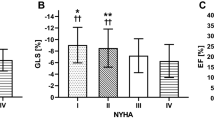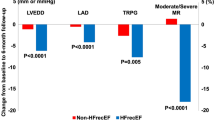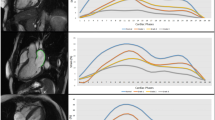Abstract
The number of patients with chronic heart failure is increasing rapidly in the Western world. Despite the introduction of new pharmacologic therapies, the prognosis of these patients remains poor. Left ventricular (LV) dyssynchrony is a frequently observed feature in patients with heart failure, and is recognized as an important predictor of poor outcome if left untreated. The presence of LV dyssynchrony leads to inefficient LV contraction with a decreased cardiac output. Moreover, patients with LV dyssynchrony are at increased risk of adverse cardiac events. New therapeutic options targeted at restoring normal mechanical synchrony, such as cardiac resynchronization therapy, have been shown to improve clinical symptoms and prognosis in patients with heart failure. The beneficial effects of cardiac resynchronization therapy are predominantly mediated by this treatment's ability to reduce LV dyssynchrony. Given these results, adequate identification of LV dyssynchrony in patients with heart failure is of paramount importance. Several new imaging techniques are proving useful for diagnosis of LV dyssynchrony. In particular, advanced echocardiographic techniques (e.g. tissue Doppler imaging) and conductance catheter techniques are two accurate methods for quantification of LV dyssynchrony. In this review, we discuss the pathophysiology, diagnosis and treatment of LV dyssynchrony in patients with heart failure.
Key Points
-
Various types of dyssynchronous activation are seen in heart failure, such as atrioventricular dyssynchrony, interventricular dyssynchrony and left intraventricular dyssynchrony
-
Left ventricular (LV) dyssynchrony in heart failure patients results in ineffective LV systolic function and worsens prognosis
-
Promising results in patients with drug-refractory heart failure are reviving interest in the possible use of cardiac resynchronization therapy for LV dyssynchrony reduction
-
LV dyssynchrony is present in 70% of patients with a wide QRS complex and 30% with a narrow QRS complex, making this feature a weak marker of LV dyssynchrony
-
New echocardiographic techniques, such as tissue Doppler imaging, provide quick and accurate quantification of LV dyssynchrony
This is a preview of subscription content, access via your institution
Access options
Subscribe to this journal
Receive 12 print issues and online access
$209.00 per year
only $17.42 per issue
Buy this article
- Purchase on Springer Link
- Instant access to full article PDF
Prices may be subject to local taxes which are calculated during checkout



Similar content being viewed by others
References
Jessup M and Brozena S (2003) Heart failure. N Engl J Med 348: 2007–2018
American Heart Association (2005) Heart disease and stroke statistics—2005 update. [http://www.americanheart.org/downloadable/heart/ 1105390918119HDSStats2005Update.pdf] (accessed 11 August 2005)
Garg R and Yusuf S ; Collaborative Group on ACE Inhibitor Trials (1995) Overview of randomized trials of angiotensin-converting enzyme inhibitors on mortality and morbidity in patients with heart failure. JAMA 273: 1450–1456
Farrell MH et al. (2002) β-blockers in heart failure: clinical applications. JAMA 287: 890–897
Stewart S et al. (2001) More 'malignant' than cancer? Five-year survival following a first admission for heart failure. Eur J Heart Fail 3: 315–322
Abraham WT et al. (2002) Cardiac resynchronization in chronic heart failure. N Engl J Med 346: 1845–1853
Bristow MR et al. (2004) Cardiac-resynchronization therapy with or without an implantable defibrillator in advanced chronic heart failure. N Engl J Med 350: 2140–2150
Cleland JG et al. for the Cardiac Resynchronization—Heart Failure (CARE-HF) Study Investigators (2005) The effect of cardiac resynchronization on morbidity and mortality in heart failure. N Engl J Med 352: 1539–1549
Bax JJ et al. (2003) Left ventricular dyssynchrony predicts benefit of cardiac resynchronization therapy in patients with end-stage heart failure before pacemaker implantation. Am J Cardiol 92: 1238–1240
Yu CM et al. (2002) Tissue Doppler echocardiographic evidence of reverse remodeling and improved synchronicity by simultaneously delaying regional contraction after biventricular pacing therapy in heart failure. Circulation 105: 438–445
Leclercq C and Kass DA (2002) Retiming the failing heart: principles and current clinical status of cardiac resynchronization. J Am Coll Cardiol 39: 194–201
Bax JJ et al. (2004) Left ventricular dyssynchrony predicts response and prognosis after cardiac resynchronization therapy. J Am Coll Cardiol 44: 1834–1840
Brutsaert DL (1987) Nonuniformity: a physiologic modulator of contraction and relaxation of the normal heart. J Am Coll Cardiol 9: 341–348
Heyndrickx GR et al. (1988) Effects of asynchrony on myocardial relaxation at rest and during exercise in conscious dogs. Am J Physiol 254: H817–H822
Villari B et al. (1996) Normalization of left ventricular nonuniformity late after valve replacement for aortic stenosis. Am J Cardiol 78: 66–71
Heyndrickx GR and Paulus WJ (1990) Effect of asynchrony on left ventricular relaxation. Circulation 81 (Suppl): SIII41–SIII47
Gepstein L et al. (1998) Electromechanical characterization of chronic myocardial infarction in the canine coronary occlusion model. Circulation 98: 2055–2064
Curry CW et al. (2000) Mechanical dyssynchrony in dilated cardiomyopathy with intraventricular conduction delay as depicted by 3D tagged magnetic resonance imaging. Circulation 101: E2
Prinzen FW et al. (1992) The time sequence of electrical and mechanical activation during spontaneous beating and ectopic stimulation. Eur Heart J 13: 535–543
Breithardt OA et al. (2002) Echocardiographic quantification of left ventricular asynchrony predicts an acute hemodynamic benefit of cardiac resynchronization therapy. J Am Coll Cardiol 40: 536–545
Sogaard P et al. (2002) Tissue Doppler imaging predicts improved systolic performance and reversed left ventricular remodeling during long-term cardiac resynchronization therapy. J Am Coll Cardiol 40: 723–730
Pitzalis MV et al. (2005) Ventricular asynchrony predicts a better outcome in patients with chronic heart failure receiving cardiac resynchronization therapy. J Am Coll Cardiol 45: 65–69
Bader H et al. (2004) Intra-left ventricular electromechanical asynchrony: a new independent predictor of severe cardiac events in heart failure patients. J Am Coll Cardiol 43: 248–256
Van de Veire N et al. (2005) Global and regional parameters of dyssynchrony in ischemic and non-ischemic cardiomyopathy. Am J Cardiol 95: 421–423
Auricchio A et al. (2004) Characterization of left ventricular activation in patients with heart failure and left bundle branch block. Circulation 109: 1133–1139
Prinzen FW et al. (1999) Mapping of regional myocardial strain and work during ventricular pacing: experimental study using magnetic resonance imaging tagging. J Am Coll Cardiol 33: 1735–1742
Spragg DD et al. (2003) Regional alterations in protein expression in the dyssynchronous failing heart. Circulation 108: 929–932
Kass D (2003) Ventricular resynchronization: pathophysiology and identification of responders. Rev Cardiovasc Med 4 (Suppl 2): S3–S13
Sweeney MO et al. (2003) Adverse effect of ventricular pacing on heart failure and atrial fibrillation among patients with normal baseline QRS duration in a clinical trial of pacemaker therapy for sinus node dysfunction. Circulation 107: 2932–2937
Thambo JB et al. (2004) Detrimental ventricular remodeling in patients with congenital complete heart block and chronic right ventricular apical pacing. Circulation 110: 3766–3772
Bleeker GB et al. (2004) Relationship between QRS duration and left ventricular dyssynchrony in patients with end-stage heart failure. J Cardiovasc Electrophysiol 15: 544–549
Yu CM et al. (2003) High prevalence of left ventricular systolic and diastolic asynchrony in patients with congestive heart failure and normal QRS duration. Heart 89: 54–60
Ghio S et al. (2004) Interventricular and intraventricular dyssynchrony are common in heart failure patients, regardless of QRS duration. Eur Heart J 25: 571–578
Fauchier L et al. (2003) Reliability of QRS duration on surface electrocardiogram to identify ventricular dyssynchrony in patients with idiopathic dilated cardiomyopathy. Am J Cardiol 92: 341–344
Yu CM et al. (2004) Tissue Doppler imaging is superior to strain rate imaging and postsystolic shortening on the prediction of reverse remodeling in both ischemic and nonischemic heart failure after cardiac resynchronization therapy. Circulation 110: 66–73
Schreuder JJ et al. (2000) Acute and short-term effects of partial left ventriculectomy in dilated cardiomyopathy: assessment by pressure-volume loops. J Am Coll Cardiol 36: 2104–2114
Steendijk P et al. (2004) Quantification of left ventricular mechanical dyssynchrony by conductance catheter in heart failure patients. Am J Physiol Heart Circ Physiol 286: H723–H730
Baan J et al. (1984) Continuous measurement of left ventricular volume in animals and humans by conductance catheter. Circulation 70: 812–823
Kass DA et al. (1988) Use of a conductance (volume) catheter and transient inferior vena caval occlusion for rapid determination of pressure-volume relationships in man. Cathet Cardiovasc Diagn 15: 192–202
Schreuder JJ et al. (2005) Acute decrease of ventricular mechanical dyssynchrony and improvement of contractile state and energy efficiency after left ventricular restoration. J Thorac Cardiovasc Surg 129: 138–145
Tulner SA et al. (2005) Acute hemodynamic effects of restrictive mitral annuloplasty in patients with end-stage heart failure—analysis by pressure-volume relations. J Thorac Cardiovasc Surg 130: 33–40
Steendijk P et al. (2004) Pressure-volume measurements by conductance catheter during cardiac resynchronization therapy. Eur Heart J 6 (Suppl): SD35–SD42
Van Der Velde ET et al. (1992) Left ventricular segmental volume by conductance catheter and cine-CT. Eur Heart J 13 (Suppl): S15–S21
Leclercq C et al. (1998) Acute hemodynamic effects of biventricular DDD pacing in patients with end-stage heart failure. J Am Coll Cardiol 32: 1825–1831
Breithardt OA et al. (2003) Acute effects of cardiac resynchronization therapy on functional mitral regurgitation in advanced systolic heart failure. J Am Coll Cardiol 41: 765–770
St John Sutton MG et al. (2003) Effect of cardiac resynchronization therapy on left ventricular size and function in chronic heart failure. Circulation 107: 1985–1990
Auricchio A et al. (2002) Cardiac resynchronization therapy restores optimal atrioventricular mechanical timing in heart failure patients with ventricular conduction delay. J Am Coll Cardiol 39: 1163–1169
Bordachar P et al. (2004) Echocardiographic parameters of ventricular dyssynchrony validation in patients with heart failure using sequential biventricular pacing. J Am Coll Cardiol 44: 2157–2165
Rossillo A et al. (2004) Impact of coronary sinus lead position on biventricular pacing: mortality and echocardiographic evaluation during follow-up. J Cardiovasc Electrophysiol 15: 1120–1125
Auricchio A et al. (2003) Clinical efficacy of cardiac resynchronization therapy using left ventricular pacing in heart failure patients stratified by severity of ventricular conduction delay. J Am Coll Cardiol 42: 2109–2116
Bordachar P et al. (2004) Biventricular pacing and left ventricular pacing in heart failure: similar hemodynamic improvement despite marked electromechanical differences. J Cardiovasc Electrophysiol 15: 1342–1347
DiDonato M et al. (2004) Surgical ventricular restoration improves mechanical intraventricular dyssynchrony in ischemic cardiomyopathy. Circulation 109: 2536–2543
DiDonato M et al.; RESTORE Group (2004) Mechanical synchrony: role of surgical ventricular restoration in correcting LV dyssynchrony during chamber rebuilding. Heart Fai Rev 9: 307–315
Schreuder JJ et al. (2005) Acute decrease of left ventricular mechanical dyssynchrony and improvement of contractile state and energy efficiency after left ventricular restoration. J Thorac Cardiovasc Surg 129: 138–145
Yu CM et al. (2005) Predictors of response to cardiac resynchronization therapy (PROSPECT)—study design. Am Heart J 129: 600–605
Author information
Authors and Affiliations
Corresponding author
Ethics declarations
Competing interests
The authors declare no competing financial interests.
Rights and permissions
About this article
Cite this article
Bleeker, G., Bax, J., Steendijk, P. et al. Left ventricular dyssynchrony in patients with heart failure: pathophysiology, diagnosis and treatment. Nat Rev Cardiol 3, 213–219 (2006). https://doi.org/10.1038/ncpcardio0505
Received:
Accepted:
Issue Date:
DOI: https://doi.org/10.1038/ncpcardio0505



